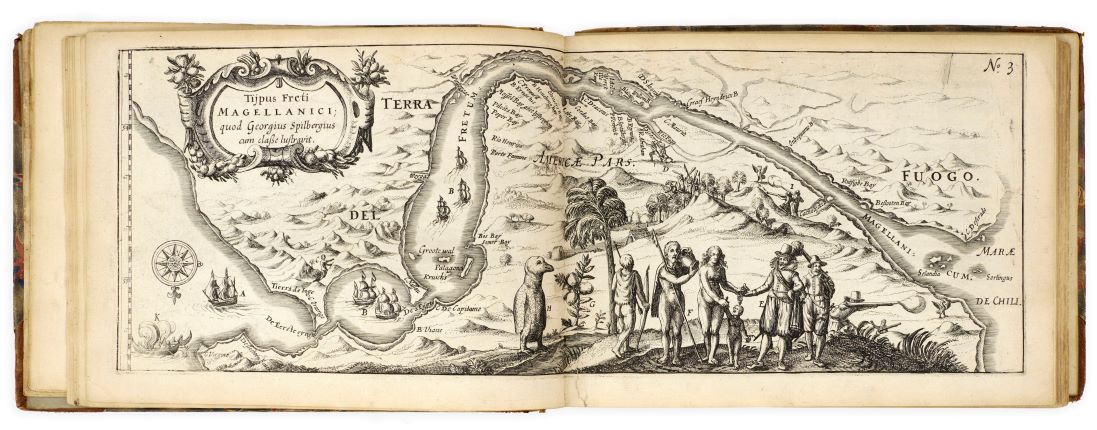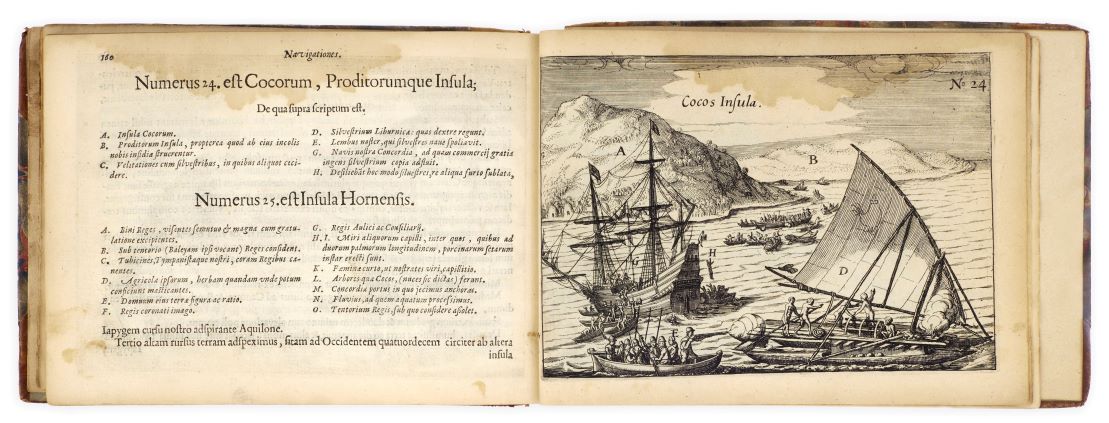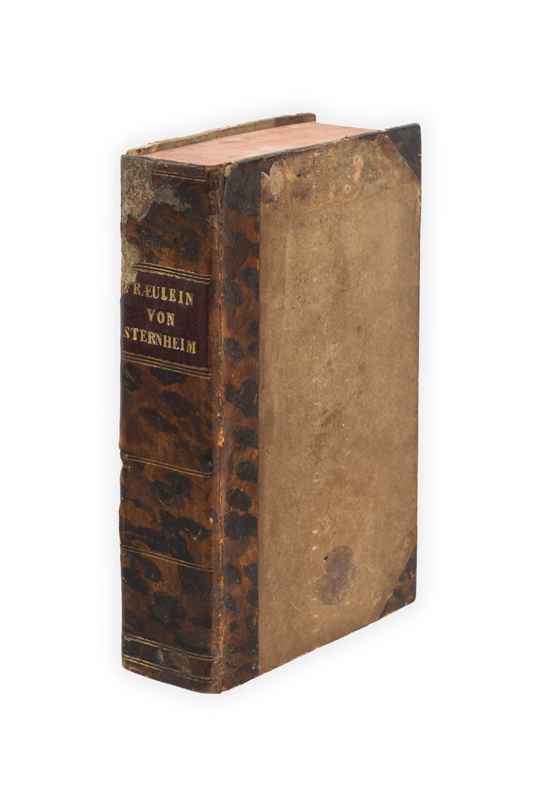

ONE OF THE CLASSIC DUTCH ILLUSTRATED VOYAGES
SPILBERGEN, Joris van, and Jacob LE MAIRE.
Speculum orientalis occidentalisque Indiae navigationum; quarum una Georgii a Spilbergen classis cum potestate praefecti, altera Iacobi le Maire auspiciis imperioque directa, annis 1614, 15, 16, 17, 18. Exhibens novi in mare australe transitus, incognitarumque hactenus terrarum ac gentium inventione[m], praelia aliquot terra marique commissa, expugnationesq[ue] urbium …
Leiden, Nicolaes van Geelkercken, 1619.
Oblong 4to, pp. 175, [1 (blank)], including blank leaf P4; with 2 folding maps and 23 plates (5 folding), large engraved vignette to title; some staining to title, strengthened at inner margin to recto and verso, some creasing to first folding map, both maps with repairs to verso, occasional marks, some damp staining to upper margins at end; overall good in 19th-century half sheep over marbled boards, gilt lettering-piece to spine; both boards detached (the upper board with endpapers and title-page attached), some wear to spine and corners; ‘Library Board of Trade’ stamp to title, a few recent notes to front pastedown.

Added to your basket:
Speculum orientalis occidentalisque Indiae navigationum; quarum una Georgii a Spilbergen classis cum potestate praefecti, altera Iacobi le Maire auspiciis imperioque directa, annis 1614, 15, 16, 17, 18. Exhibens novi in mare australe transitus, incognitarumque hactenus terrarum ac gentium inventione[m], praelia aliquot terra marique commissa, expugnationesq[ue] urbium …
First Latin edition of one of the classic Dutch illustrated voyages, identical in format and illustration to the same publisher’s Dutch-language edition of the same year. ‘All first editions in oblong format are rare and much sought after’ (Borba de Moraes p. 828). The maps include the Straits of Magellan, Le Maire’s route (showing the strait he discovered round the east of Tierra del Fuego and which is named after him), and the East Indies. The world map shows the routes of both Spilbergen and Le Maire and, in a rectangular panel at the bottom, Le Maire’s discoveries along the northern coast of New Guinea (Shirley 304). Among the plates are portrayals of battle-scenes, various ports on the Pacific coast of Spanish America as far north as Acapulco, Manila Bay, and various harbours and islands in the western Pacific and Indonesia.
The Speculum orientalis occidentalisque Indiae – the ‘East and West Indian mirror’ – narrates two highly important Dutch expeditions to the East Indies via South America and across the Pacific. The first, a powerful East India Company (VOC) fleet under the command of Spilbergen, was essentially predatory, raiding Spanish shipping and settlements; it also aimed to assert the VOC’s exclusive passage to the Pacific through the Strait of Magellan, countering challenges by its Dutch rivals. After clearing the Strait, Spilbergen’s fleet worked its way up the South American coast, sacking Spanish settlements and attacking Spanish shipping, until it reached Acapulco. It then crossed the Pacific to the Philippines and Ternate, where it hoped to intercept the Spanish force rumoured to be about to descend on the Dutch outposts in the Moluccas. Finally, Spilbergen headed for Batavia, where he encountered Jacob Le Maire and Willem Corneliszoon Schouten, whose expedition is the other voyage recounted in this volume. Their papers, ship (the Eendracht) and crew were immediately seized by the VOC, which saw this independent venture as a serious infringement of its monopoly, and Le Maire and Schouten were taken back to the Netherlands with Spilbergen. Spilbergen’s expedition was not intended to be one of ‘discovery’, but it nevertheless stands out as being exceptionally well-managed, the fifth circumnavigation of the globe, and ‘the first to sail half-way round the world with a whole fleet well in hand’ (Spate II p. 21).
Jacob Le Maire and Schouten had been sent by the Australische Compagnie, formed by Isaac Le Maire (Jacob’s father), to discover a new passage to the Pacific south of the Strait of Magellan, thereby circumventing the VOC’s exclusive rights, and to trade in any lands they discovered in the South Pacific – hopes of finding the southern continent promised in Quiros’s memorials were high. They were successful in their first objective, sailing to the Le Maire Strait, which separates Tierra del Fuego from Staten Island, and into the Pacific round Cape Horn (named after Hoorn, their home-base), but the southern continent proved elusive. Although commercially motivated, their expedition may be considered as ‘the one genuine voyage of Oceanic exploration between Quiros and Tasman’ (Spate II p. 23). Le Maire died at sea on the way home with Spilbergen, but after several years litigation his father successfully sued the VOC for the return of his son’s journal and was awarded damages.
Borba de Moraes p. 826; Howgego S159; Landwehr, VOC 361; Sabin 89450.

